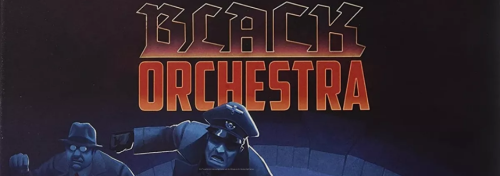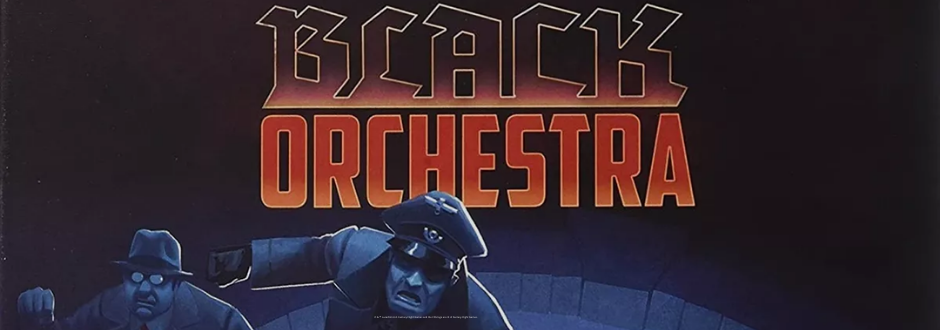Black Orchestra is a cooperative board game that immerses players in the dark era of World War II, specifically focusing on the efforts of the German resistance to overthrow Adolf Hitler. The game's title, "Black Orchestra," refers to the real historical name given to a group within the German military and government who conspired to assassinate Hitler. Designed for 1 to 5 players, the game allows participants to take on the roles of these actual historical figures, each with their unique abilities, as they work together to plan and execute a plot to eliminate the Führer.
Historical Backdrop
The game is set against the backdrop of Nazi Germany, starting from the early years of Hitler's rise to power in the 1930s, through World War II, to the fall of the Third Reich. This period is meticulously represented in the game, both through the artwork and the event cards, which are based on actual historical events, decisions, and dilemmas faced by the German resistance. The setting not only serves to create a tense and thematic atmosphere but also aims to educate players about this critical period in history.
Key Mechanics
Black Orchestra combines elements of strategy, teamwork, and historical education through several key mechanics:
● Plot Cards and Actions: Players collect Plot cards that represent various plans to assassinate Hitler. These plots require specific items and conditions to be successful. Throughout the game, players use their actions to move around Europe, gather items, draw cards, and perform special actions unique to their character.
● Suspicion and Morale: The game features a suspicion mechanic where players must avoid drawing too much attention to their activities, lest they be arrested by the Gestapo. Additionally, the morale track reflects the overall hope and determination of the resistance. High morale allows for more efficient actions, while low morale can severely hinder the group's efforts.
● Event Deck and Time Pressure: The game is driven by an event deck that simulates the progression of World War II, introducing new challenges and scenarios that the players must adapt to. This mechanic adds a sense of time pressure, as players must successfully assassinate Hitler before the deck runs out, symbolizing the end of the war and the failure of their mission.
Number of Players
Black Orchestra is designed for 1 to 5 players, making it accessible for solo play as well as group play. The game scales in difficulty based on the number of players, ensuring a challenging yet manageable experience regardless of the group size. The cooperative nature of the game emphasizes teamwork and strategic planning, as players must communicate and coordinate their actions to overcome the challenges presented by the game and successfully change the course of history.
How to win
Winning Black Orchestra requires players to navigate a treacherous path filled with danger, suspicion, and shifting political landscapes. Understanding how to lose is a crucial first step in devising strategies to win. Players can lose in several ways: if all players are arrested and in prison simultaneously, if the game reaches a certain point without successfully assassinating Hitler. These losing conditions underscore the game's balance between risk and reward, the importance of timing, and the need for careful planning and coordination among players.
Navigating Random Events
One of the core challenges in Black Orchestra is the unpredictability of random events, which can drastically alter plans or opportunities. These events simulate the uncertainty and volatile nature of conspiring against a totalitarian regime. To mitigate the impact of unfavourable events, players should:
● Stay Flexible: Maintain a flexible strategy that can adapt to changing conditions. Avoid overly committing to a single plot too early without considering alternate paths to victory.
● Prepare for Contingencies: Collect a diverse range of items and plot cards. This diversity allows players to pivot to different assassination attempts as conditions change.
● Manage Risk: Gauge when to push forward with plans and when to lay low. Sometimes, avoiding suspicion or arrest is more crucial than advancing a plot.
Hitler's Support and Strategic Implications
The fluctuating level of Hitler's support throughout the game reflects his changing popularity and the war's progress. As the war advances, Hitler's support may rise or fall, affecting the difficulty of assassination attempts. Strategic considerations include:
● Timing: Early in the game, Hitler's support might be lower, making successful plots more probable. As the war progresses and Hitler's support potentially increases, assassination attempts might have a lower chance of success. Players might focus on gathering resources and lowering their suspicion levels.
● Location: Hitler's location changes. Players must strategically decide when and where to strike, balancing the plot's requirements.
● Support Cards: Use Event and Support cards effectively to reduce Hitler's support. These cards can create openings for assassination attempts or mitigate the game's challenges.
Winning Strategies
To win Black Orchestra, players must:
● Communicate and Collaborate: Share resources, plan jointly, and leverage each character's unique abilities. Coordination is key to managing resources, reducing suspicion, and executing plots.
● Optimize Actions: Every action counts. Move efficiently, plan actions to reduce travel time, and align actions with the group's strategy.
● Stay Adaptable: Be ready to change plans based on new information, events, and opportunities. Adaptability is crucial in responding to the dynamic challenges posed by the game.
In summary, winning in Black Orchestra demands a blend of strategic planning, adaptability, and cooperation. Players must navigate the game's inherent randomness, manage the evolving challenge of Hitler's support, and make calculated decisions to pave their way to victory. By understanding how to lose and adapting strategies to address the game's fluctuating conditions, players can successfully orchestrate the downfall of one of history's most notorious tyrants.
How to teach
Despite its deep strategic gameplay and historical complexity, Black Orchestra is relatively easy to teach and learn, making it accessible to new players as well as enjoyable for seasoned board gamers. One of the game's strengths in terms of teachability is that all the key rules are printed directly on the game board. This design choice significantly reduces the need to constantly refer to the rulebook, allowing players to quickly understand the core mechanics and focus on the strategy and story unfolding before them.
Furthermore, Black Orchestra includes some excellent player aids that summarise crucial information and game phases. These aids serve as quick reference guides, helping players keep track of their options and the game's progression without getting overwhelmed. The inclusion of these aids, along with the intuitive design of the game board, ensures that players can easily grasp the game's basics and dive into the experience of plotting to change the course of history. This ease of learning, coupled with the game's engaging theme and cooperative play, makes Black Orchestra a standout choice for game nights.
Summary
In summary, Black Orchestra offers a unique blend of historical simulation, strategic gameplay, and cooperative interaction. Players are not only tasked with plotting to change the course of history but are also reminded of the courage and moral dilemmas faced by those who dared to stand against tyranny. It's a game that not only entertains but also educates and inspires, making it a remarkable addition to the world of board games.





